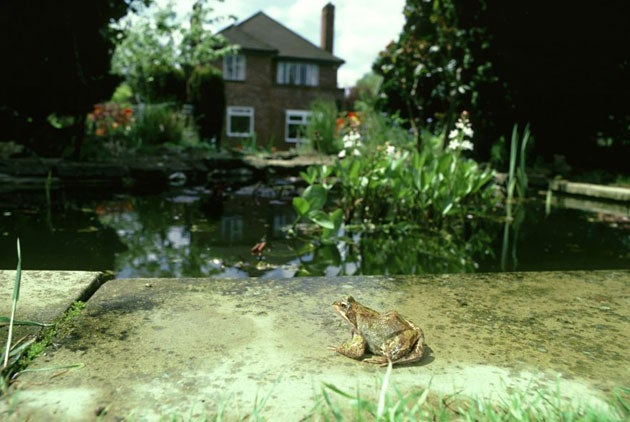Come on in, the wildlife's lovely
As the Million Ponds Project gains plaudits from the Environment Agency after just 18 months, Gillian Orr dips a toe into the nature sanctuary at the bottom of the garden

Rare amphibians nestle cheek-by-jowl with seldom-seen insects. Shy mammals swim alongside the fearsome-sounding toothed threadwort. This wet wildlife wonderland might sound as if it's found in the depths of the Amazon or the shallows of the Nile, but it's actually happening a lot closer to home. In fact, it could be the bottom of your garden.
You may be surprised to hear so much activity takes place in a pond. Despite being transformed into "water features" by enterprising television makeover shows, ponds are actually a vital and fascinating part of the ecosystem. But their very existence has been under threat and the number of ponds in England and Wales have declined by nearly three-quarters, from 800,000 to the present total of 250,000, mainly due to neglect. That is, until Pond Conservation stepped in.
The charity launched the Million Ponds Project in February last year, its main aim being to increase the number of ponds in England and Wales to one million. It is a huge project with a 50-year timeline, the first phase involving the creation of 5,000 ponds by 2012 at a cost of £3m.
So why all the effort? Clean water ponds are an easy way to support sensitive plants and animals and there are more than 50 threatened species that rely on ponds for survival and are a national priority for conservation under the UK Biodiversity Action Plan (BAP), including the tadpole shrimp, the natterjack toad and the one-grooved diving beetle. Not only are they a home for plants, insects, crustaceans and amphibians, they are an important part of the ecosystem: research suggests that ponds absorb more carbon than the world's oceans. Dr Jeremy Biggs, Pond Conservation's director, says: "It's hard to clean up our lowland streams, rivers and lakes so that they can support very high quality wildlife. But you can make a new clean water pond instantaneously – and it will help to protect our freshwater wildlife for centuries." Not to mention them being an aesthetically pleasing part of the environment.
But it's not all about creating new ponds. The Million Ponds Project also plans to restore damaged ones and improve water quality. Most countryside ponds have polluted inflows and many are stocked for angling so they are unlikely to develop or sustain biodiversity. The project aims to tackle these problems.
Of course the big question is where the money to pay for the project during these tough financial times is flowing from. Million Ponds Project is a collaboration between landowners and land managers, co-ordinated by Pond Conservation. Partner organisations include Defence Estates, the Environment Agency, RSPB, Ministry of Justice and the Forestry Commission, who are all creating hundreds of ponds on their property. Biffa Waste Services has introduced the Biffaward, which is a fund to support pond creation for BAP species. People are invited to submit a request for funding and depending on location, the species it will benefit and value for money, they will be considered for funding. Other organisations are offering their time and expertise, such as Buglife, the Aquatic Coleoptera Conservation Trust and Amphibian and Reptile Conservation. It is heart-warming to see so many organisations pulling together with a common objective.
The project also encourages the public to get involved and it invites anyone to create their own pond – officially, a seasonal or permanent waterbody of one metre squared to two hectares. There are three main criteria for new ponds: that they are a clean water source, that they are left to colonise naturally and that they are left to thrive naturally. The Pond Conservation website carries a creation toolkit to download which includes a series of factsheets, and they are planning to introduce case studies and photo guides as well. When completed, you are asked to register your pond, citing its ordnance survey grid reference, the type of water source it has and whether the pond was made for the BAP species associated with ponds. There are also project officers available to provide advice and training for larger organisations and projects.
Dr Pascale Nicolet, Million Ponds Project manager, says proudly: "In its first one and a half years, Million Ponds has exceeded all its targets. There are now over a thousand new clean water ponds in the countryside providing a home for Britain's wonderful freshwater wildlife."
Pond Conservation is hoping that if all goes to plan, people will really notice a change in five to 10 years. In an austere time, with many organisations being subjected to huge cuts, who could not be a little cheered to see ponds, and all the life they sustain, thriving?
Your Independent: Nature Club
To take part in The Independent’s Nature Club, email your wildlife observations to natureclub [at] independent.co.uk; the best entries will be published each month
Join our commenting forum
Join thought-provoking conversations, follow other Independent readers and see their replies
Comments
Bookmark popover
Removed from bookmarks